Review of Internal Combustion Engines: Theory, Performance, and Fuels
VerifiedAdded on 2022/08/08
|5
|2015
|62
Report
AI Summary
This report provides a comprehensive overview of internal combustion (IC) engines, covering their working principles, classification, and key components. It delves into the operational cycles of both four-stroke and two-stroke engines, highlighting the differences and advantages of each. The core of the report is a critical review of a study by Efemwenkiekie et al. (2019), which investigates the performance of a four-stroke spark-ignited (SI) engine using ethanol-gasoline blends as an alternative fuel. The report analyzes the impact of these blends on engine parameters such as brake power, brake thermal efficiency, engine torque, and brake specific fuel consumption. The review also references supporting research by Tibaquirá et al. (2018), emphasizing the environmental benefits, such as reduced volatile organic compound emissions, associated with the use of ethanol-gasoline mixtures. The report concludes by advocating for further research and utilization of alternative fuels like ethanol to improve engine performance and reduce emissions.
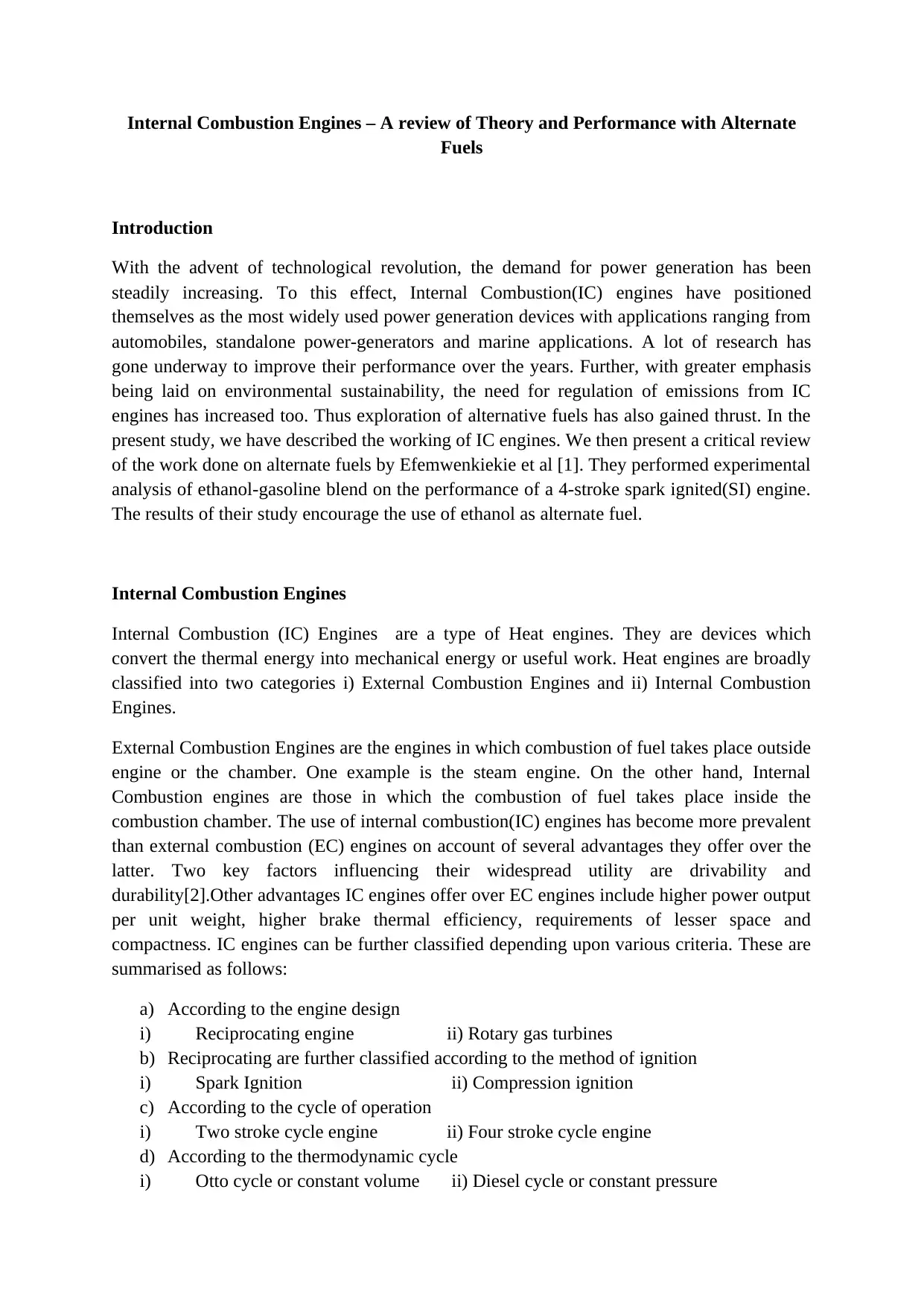
Internal Combustion Engines – A review of Theory and Performance with Alternate
Fuels
Introduction
With the advent of technological revolution, the demand for power generation has been
steadily increasing. To this effect, Internal Combustion(IC) engines have positioned
themselves as the most widely used power generation devices with applications ranging from
automobiles, standalone power-generators and marine applications. A lot of research has
gone underway to improve their performance over the years. Further, with greater emphasis
being laid on environmental sustainability, the need for regulation of emissions from IC
engines has increased too. Thus exploration of alternative fuels has also gained thrust. In the
present study, we have described the working of IC engines. We then present a critical review
of the work done on alternate fuels by Efemwenkiekie et al [1]. They performed experimental
analysis of ethanol-gasoline blend on the performance of a 4-stroke spark ignited(SI) engine.
The results of their study encourage the use of ethanol as alternate fuel.
Internal Combustion Engines
Internal Combustion (IC) Engines are a type of Heat engines. They are devices which
convert the thermal energy into mechanical energy or useful work. Heat engines are broadly
classified into two categories i) External Combustion Engines and ii) Internal Combustion
Engines.
External Combustion Engines are the engines in which combustion of fuel takes place outside
engine or the chamber. One example is the steam engine. On the other hand, Internal
Combustion engines are those in which the combustion of fuel takes place inside the
combustion chamber. The use of internal combustion(IC) engines has become more prevalent
than external combustion (EC) engines on account of several advantages they offer over the
latter. Two key factors influencing their widespread utility are drivability and
durability[2].Other advantages IC engines offer over EC engines include higher power output
per unit weight, higher brake thermal efficiency, requirements of lesser space and
compactness. IC engines can be further classified depending upon various criteria. These are
summarised as follows:
a) According to the engine design
i) Reciprocating engine ii) Rotary gas turbines
b) Reciprocating are further classified according to the method of ignition
i) Spark Ignition ii) Compression ignition
c) According to the cycle of operation
i) Two stroke cycle engine ii) Four stroke cycle engine
d) According to the thermodynamic cycle
i) Otto cycle or constant volume ii) Diesel cycle or constant pressure
Fuels
Introduction
With the advent of technological revolution, the demand for power generation has been
steadily increasing. To this effect, Internal Combustion(IC) engines have positioned
themselves as the most widely used power generation devices with applications ranging from
automobiles, standalone power-generators and marine applications. A lot of research has
gone underway to improve their performance over the years. Further, with greater emphasis
being laid on environmental sustainability, the need for regulation of emissions from IC
engines has increased too. Thus exploration of alternative fuels has also gained thrust. In the
present study, we have described the working of IC engines. We then present a critical review
of the work done on alternate fuels by Efemwenkiekie et al [1]. They performed experimental
analysis of ethanol-gasoline blend on the performance of a 4-stroke spark ignited(SI) engine.
The results of their study encourage the use of ethanol as alternate fuel.
Internal Combustion Engines
Internal Combustion (IC) Engines are a type of Heat engines. They are devices which
convert the thermal energy into mechanical energy or useful work. Heat engines are broadly
classified into two categories i) External Combustion Engines and ii) Internal Combustion
Engines.
External Combustion Engines are the engines in which combustion of fuel takes place outside
engine or the chamber. One example is the steam engine. On the other hand, Internal
Combustion engines are those in which the combustion of fuel takes place inside the
combustion chamber. The use of internal combustion(IC) engines has become more prevalent
than external combustion (EC) engines on account of several advantages they offer over the
latter. Two key factors influencing their widespread utility are drivability and
durability[2].Other advantages IC engines offer over EC engines include higher power output
per unit weight, higher brake thermal efficiency, requirements of lesser space and
compactness. IC engines can be further classified depending upon various criteria. These are
summarised as follows:
a) According to the engine design
i) Reciprocating engine ii) Rotary gas turbines
b) Reciprocating are further classified according to the method of ignition
i) Spark Ignition ii) Compression ignition
c) According to the cycle of operation
i) Two stroke cycle engine ii) Four stroke cycle engine
d) According to the thermodynamic cycle
i) Otto cycle or constant volume ii) Diesel cycle or constant pressure
Paraphrase This Document
Need a fresh take? Get an instant paraphrase of this document with our AI Paraphraser
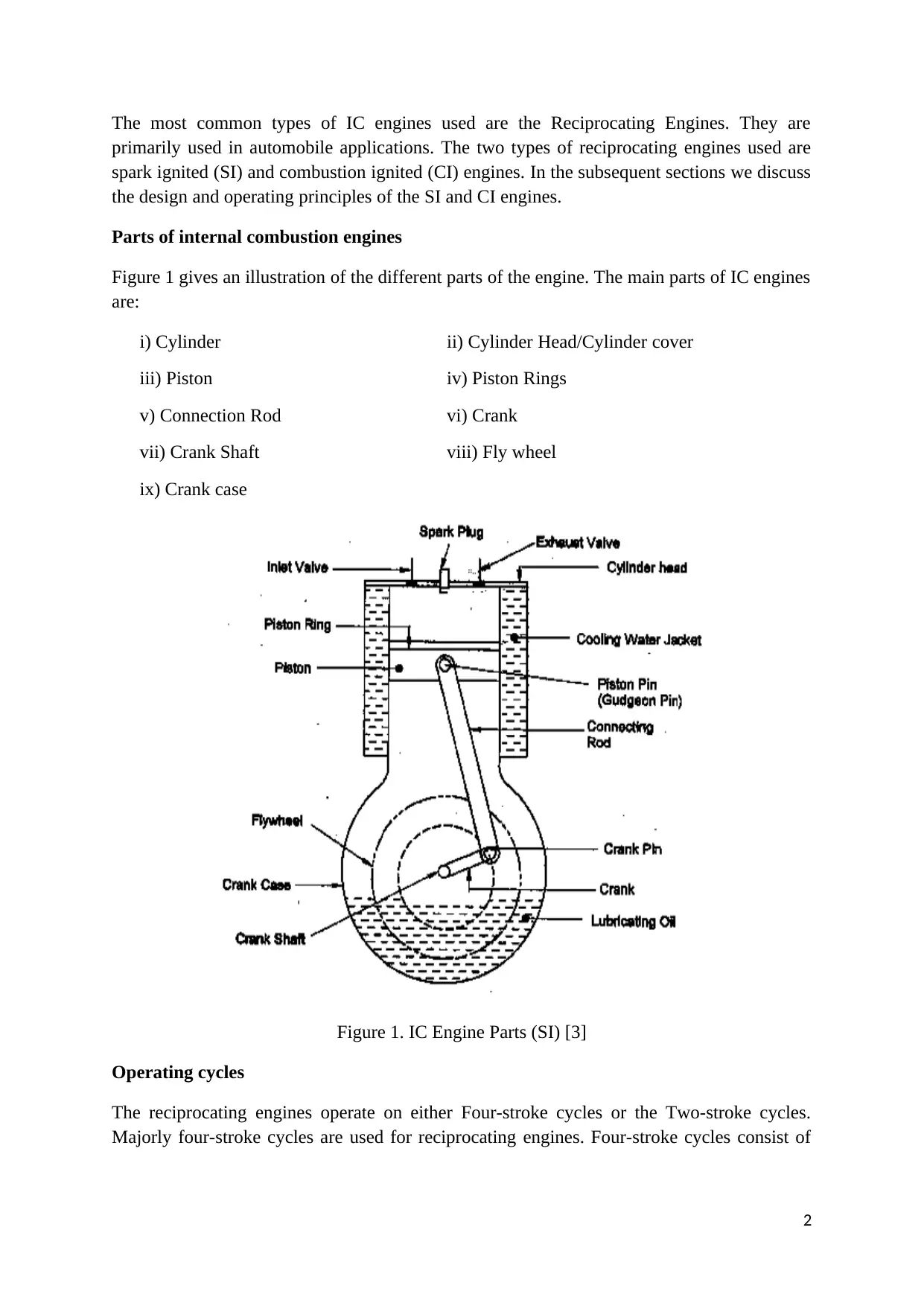
The most common types of IC engines used are the Reciprocating Engines. They are
primarily used in automobile applications. The two types of reciprocating engines used are
spark ignited (SI) and combustion ignited (CI) engines. In the subsequent sections we discuss
the design and operating principles of the SI and CI engines.
Parts of internal combustion engines
Figure 1 gives an illustration of the different parts of the engine. The main parts of IC engines
are:
i) Cylinder ii) Cylinder Head/Cylinder cover
iii) Piston iv) Piston Rings
v) Connection Rod vi) Crank
vii) Crank Shaft viii) Fly wheel
ix) Crank case
Figure 1. IC Engine Parts (SI) [3]
Operating cycles
The reciprocating engines operate on either Four-stroke cycles or the Two-stroke cycles.
Majorly four-stroke cycles are used for reciprocating engines. Four-stroke cycles consist of
2
primarily used in automobile applications. The two types of reciprocating engines used are
spark ignited (SI) and combustion ignited (CI) engines. In the subsequent sections we discuss
the design and operating principles of the SI and CI engines.
Parts of internal combustion engines
Figure 1 gives an illustration of the different parts of the engine. The main parts of IC engines
are:
i) Cylinder ii) Cylinder Head/Cylinder cover
iii) Piston iv) Piston Rings
v) Connection Rod vi) Crank
vii) Crank Shaft viii) Fly wheel
ix) Crank case
Figure 1. IC Engine Parts (SI) [3]
Operating cycles
The reciprocating engines operate on either Four-stroke cycles or the Two-stroke cycles.
Majorly four-stroke cycles are used for reciprocating engines. Four-stroke cycles consist of
2
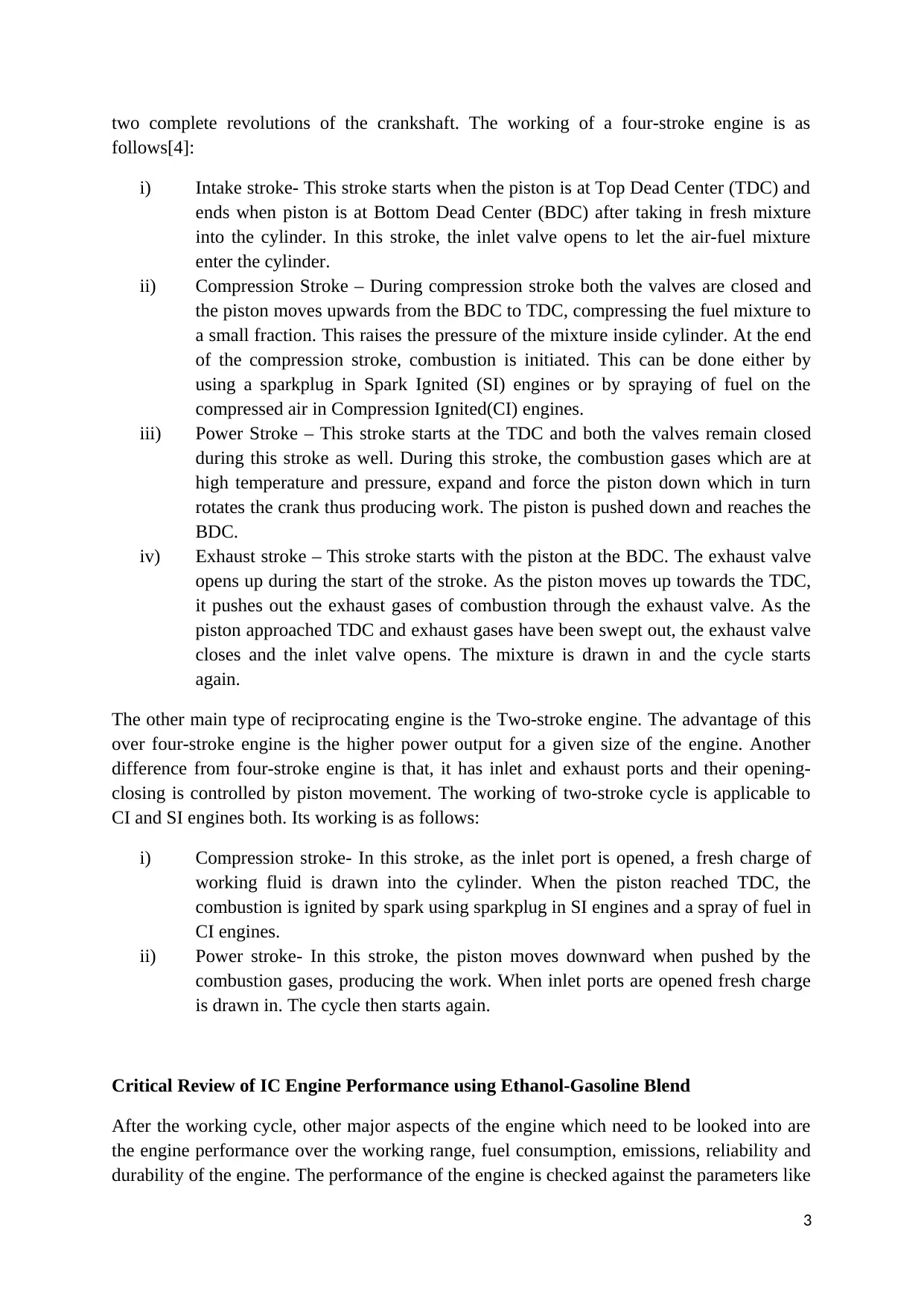
two complete revolutions of the crankshaft. The working of a four-stroke engine is as
follows[4]:
i) Intake stroke- This stroke starts when the piston is at Top Dead Center (TDC) and
ends when piston is at Bottom Dead Center (BDC) after taking in fresh mixture
into the cylinder. In this stroke, the inlet valve opens to let the air-fuel mixture
enter the cylinder.
ii) Compression Stroke – During compression stroke both the valves are closed and
the piston moves upwards from the BDC to TDC, compressing the fuel mixture to
a small fraction. This raises the pressure of the mixture inside cylinder. At the end
of the compression stroke, combustion is initiated. This can be done either by
using a sparkplug in Spark Ignited (SI) engines or by spraying of fuel on the
compressed air in Compression Ignited(CI) engines.
iii) Power Stroke – This stroke starts at the TDC and both the valves remain closed
during this stroke as well. During this stroke, the combustion gases which are at
high temperature and pressure, expand and force the piston down which in turn
rotates the crank thus producing work. The piston is pushed down and reaches the
BDC.
iv) Exhaust stroke – This stroke starts with the piston at the BDC. The exhaust valve
opens up during the start of the stroke. As the piston moves up towards the TDC,
it pushes out the exhaust gases of combustion through the exhaust valve. As the
piston approached TDC and exhaust gases have been swept out, the exhaust valve
closes and the inlet valve opens. The mixture is drawn in and the cycle starts
again.
The other main type of reciprocating engine is the Two-stroke engine. The advantage of this
over four-stroke engine is the higher power output for a given size of the engine. Another
difference from four-stroke engine is that, it has inlet and exhaust ports and their opening-
closing is controlled by piston movement. The working of two-stroke cycle is applicable to
CI and SI engines both. Its working is as follows:
i) Compression stroke- In this stroke, as the inlet port is opened, a fresh charge of
working fluid is drawn into the cylinder. When the piston reached TDC, the
combustion is ignited by spark using sparkplug in SI engines and a spray of fuel in
CI engines.
ii) Power stroke- In this stroke, the piston moves downward when pushed by the
combustion gases, producing the work. When inlet ports are opened fresh charge
is drawn in. The cycle then starts again.
Critical Review of IC Engine Performance using Ethanol-Gasoline Blend
After the working cycle, other major aspects of the engine which need to be looked into are
the engine performance over the working range, fuel consumption, emissions, reliability and
durability of the engine. The performance of the engine is checked against the parameters like
3
follows[4]:
i) Intake stroke- This stroke starts when the piston is at Top Dead Center (TDC) and
ends when piston is at Bottom Dead Center (BDC) after taking in fresh mixture
into the cylinder. In this stroke, the inlet valve opens to let the air-fuel mixture
enter the cylinder.
ii) Compression Stroke – During compression stroke both the valves are closed and
the piston moves upwards from the BDC to TDC, compressing the fuel mixture to
a small fraction. This raises the pressure of the mixture inside cylinder. At the end
of the compression stroke, combustion is initiated. This can be done either by
using a sparkplug in Spark Ignited (SI) engines or by spraying of fuel on the
compressed air in Compression Ignited(CI) engines.
iii) Power Stroke – This stroke starts at the TDC and both the valves remain closed
during this stroke as well. During this stroke, the combustion gases which are at
high temperature and pressure, expand and force the piston down which in turn
rotates the crank thus producing work. The piston is pushed down and reaches the
BDC.
iv) Exhaust stroke – This stroke starts with the piston at the BDC. The exhaust valve
opens up during the start of the stroke. As the piston moves up towards the TDC,
it pushes out the exhaust gases of combustion through the exhaust valve. As the
piston approached TDC and exhaust gases have been swept out, the exhaust valve
closes and the inlet valve opens. The mixture is drawn in and the cycle starts
again.
The other main type of reciprocating engine is the Two-stroke engine. The advantage of this
over four-stroke engine is the higher power output for a given size of the engine. Another
difference from four-stroke engine is that, it has inlet and exhaust ports and their opening-
closing is controlled by piston movement. The working of two-stroke cycle is applicable to
CI and SI engines both. Its working is as follows:
i) Compression stroke- In this stroke, as the inlet port is opened, a fresh charge of
working fluid is drawn into the cylinder. When the piston reached TDC, the
combustion is ignited by spark using sparkplug in SI engines and a spray of fuel in
CI engines.
ii) Power stroke- In this stroke, the piston moves downward when pushed by the
combustion gases, producing the work. When inlet ports are opened fresh charge
is drawn in. The cycle then starts again.
Critical Review of IC Engine Performance using Ethanol-Gasoline Blend
After the working cycle, other major aspects of the engine which need to be looked into are
the engine performance over the working range, fuel consumption, emissions, reliability and
durability of the engine. The performance of the engine is checked against the parameters like
3
⊘ This is a preview!⊘
Do you want full access?
Subscribe today to unlock all pages.

Trusted by 1+ million students worldwide
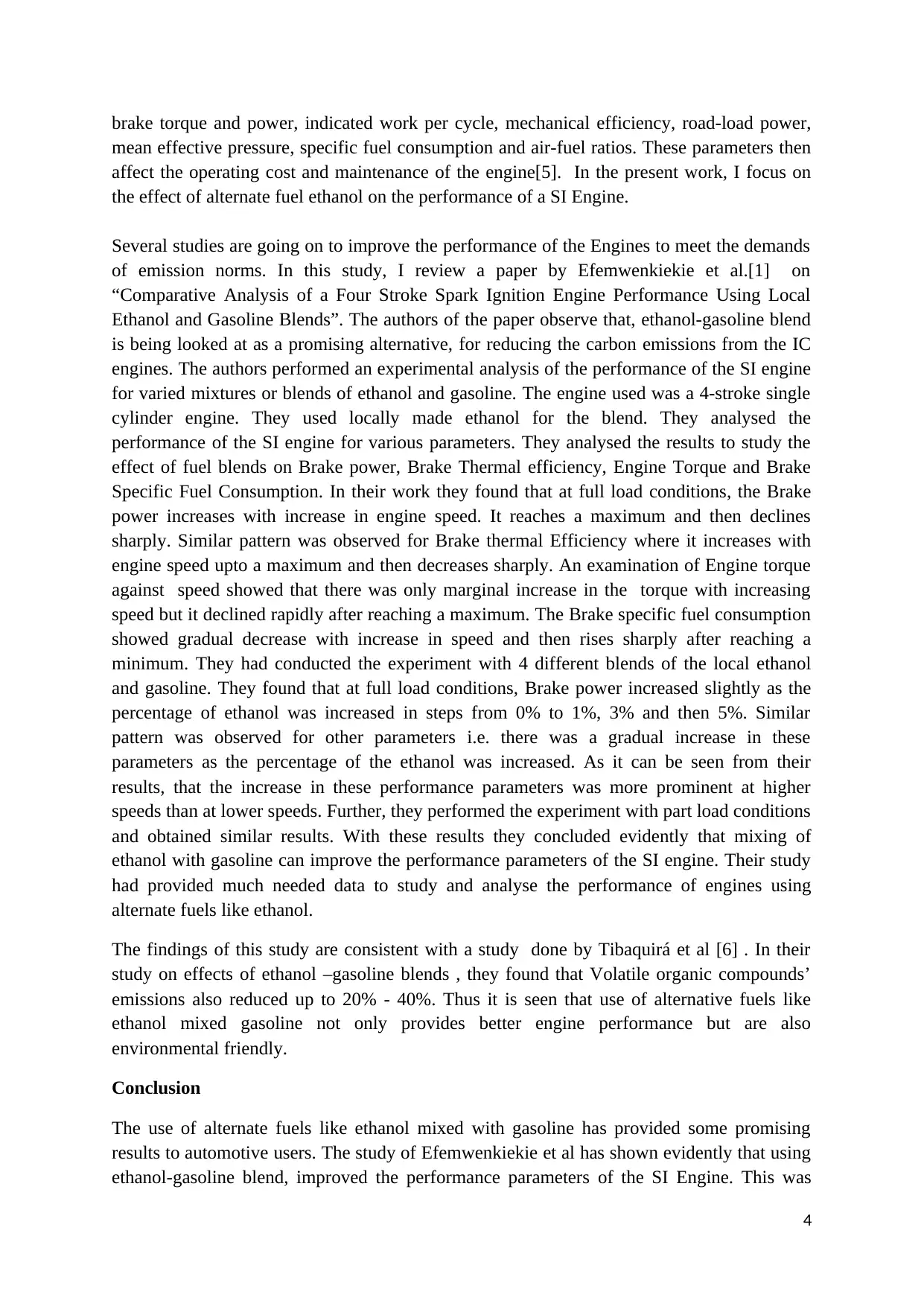
brake torque and power, indicated work per cycle, mechanical efficiency, road-load power,
mean effective pressure, specific fuel consumption and air-fuel ratios. These parameters then
affect the operating cost and maintenance of the engine[5]. In the present work, I focus on
the effect of alternate fuel ethanol on the performance of a SI Engine.
Several studies are going on to improve the performance of the Engines to meet the demands
of emission norms. In this study, I review a paper by Efemwenkiekie et al.[1] on
“Comparative Analysis of a Four Stroke Spark Ignition Engine Performance Using Local
Ethanol and Gasoline Blends”. The authors of the paper observe that, ethanol-gasoline blend
is being looked at as a promising alternative, for reducing the carbon emissions from the IC
engines. The authors performed an experimental analysis of the performance of the SI engine
for varied mixtures or blends of ethanol and gasoline. The engine used was a 4-stroke single
cylinder engine. They used locally made ethanol for the blend. They analysed the
performance of the SI engine for various parameters. They analysed the results to study the
effect of fuel blends on Brake power, Brake Thermal efficiency, Engine Torque and Brake
Specific Fuel Consumption. In their work they found that at full load conditions, the Brake
power increases with increase in engine speed. It reaches a maximum and then declines
sharply. Similar pattern was observed for Brake thermal Efficiency where it increases with
engine speed upto a maximum and then decreases sharply. An examination of Engine torque
against speed showed that there was only marginal increase in the torque with increasing
speed but it declined rapidly after reaching a maximum. The Brake specific fuel consumption
showed gradual decrease with increase in speed and then rises sharply after reaching a
minimum. They had conducted the experiment with 4 different blends of the local ethanol
and gasoline. They found that at full load conditions, Brake power increased slightly as the
percentage of ethanol was increased in steps from 0% to 1%, 3% and then 5%. Similar
pattern was observed for other parameters i.e. there was a gradual increase in these
parameters as the percentage of the ethanol was increased. As it can be seen from their
results, that the increase in these performance parameters was more prominent at higher
speeds than at lower speeds. Further, they performed the experiment with part load conditions
and obtained similar results. With these results they concluded evidently that mixing of
ethanol with gasoline can improve the performance parameters of the SI engine. Their study
had provided much needed data to study and analyse the performance of engines using
alternate fuels like ethanol.
The findings of this study are consistent with a study done by Tibaquirá et al [6] . In their
study on effects of ethanol –gasoline blends , they found that Volatile organic compounds’
emissions also reduced up to 20% - 40%. Thus it is seen that use of alternative fuels like
ethanol mixed gasoline not only provides better engine performance but are also
environmental friendly.
Conclusion
The use of alternate fuels like ethanol mixed with gasoline has provided some promising
results to automotive users. The study of Efemwenkiekie et al has shown evidently that using
ethanol-gasoline blend, improved the performance parameters of the SI Engine. This was
4
mean effective pressure, specific fuel consumption and air-fuel ratios. These parameters then
affect the operating cost and maintenance of the engine[5]. In the present work, I focus on
the effect of alternate fuel ethanol on the performance of a SI Engine.
Several studies are going on to improve the performance of the Engines to meet the demands
of emission norms. In this study, I review a paper by Efemwenkiekie et al.[1] on
“Comparative Analysis of a Four Stroke Spark Ignition Engine Performance Using Local
Ethanol and Gasoline Blends”. The authors of the paper observe that, ethanol-gasoline blend
is being looked at as a promising alternative, for reducing the carbon emissions from the IC
engines. The authors performed an experimental analysis of the performance of the SI engine
for varied mixtures or blends of ethanol and gasoline. The engine used was a 4-stroke single
cylinder engine. They used locally made ethanol for the blend. They analysed the
performance of the SI engine for various parameters. They analysed the results to study the
effect of fuel blends on Brake power, Brake Thermal efficiency, Engine Torque and Brake
Specific Fuel Consumption. In their work they found that at full load conditions, the Brake
power increases with increase in engine speed. It reaches a maximum and then declines
sharply. Similar pattern was observed for Brake thermal Efficiency where it increases with
engine speed upto a maximum and then decreases sharply. An examination of Engine torque
against speed showed that there was only marginal increase in the torque with increasing
speed but it declined rapidly after reaching a maximum. The Brake specific fuel consumption
showed gradual decrease with increase in speed and then rises sharply after reaching a
minimum. They had conducted the experiment with 4 different blends of the local ethanol
and gasoline. They found that at full load conditions, Brake power increased slightly as the
percentage of ethanol was increased in steps from 0% to 1%, 3% and then 5%. Similar
pattern was observed for other parameters i.e. there was a gradual increase in these
parameters as the percentage of the ethanol was increased. As it can be seen from their
results, that the increase in these performance parameters was more prominent at higher
speeds than at lower speeds. Further, they performed the experiment with part load conditions
and obtained similar results. With these results they concluded evidently that mixing of
ethanol with gasoline can improve the performance parameters of the SI engine. Their study
had provided much needed data to study and analyse the performance of engines using
alternate fuels like ethanol.
The findings of this study are consistent with a study done by Tibaquirá et al [6] . In their
study on effects of ethanol –gasoline blends , they found that Volatile organic compounds’
emissions also reduced up to 20% - 40%. Thus it is seen that use of alternative fuels like
ethanol mixed gasoline not only provides better engine performance but are also
environmental friendly.
Conclusion
The use of alternate fuels like ethanol mixed with gasoline has provided some promising
results to automotive users. The study of Efemwenkiekie et al has shown evidently that using
ethanol-gasoline blend, improved the performance parameters of the SI Engine. This was
4
Paraphrase This Document
Need a fresh take? Get an instant paraphrase of this document with our AI Paraphraser
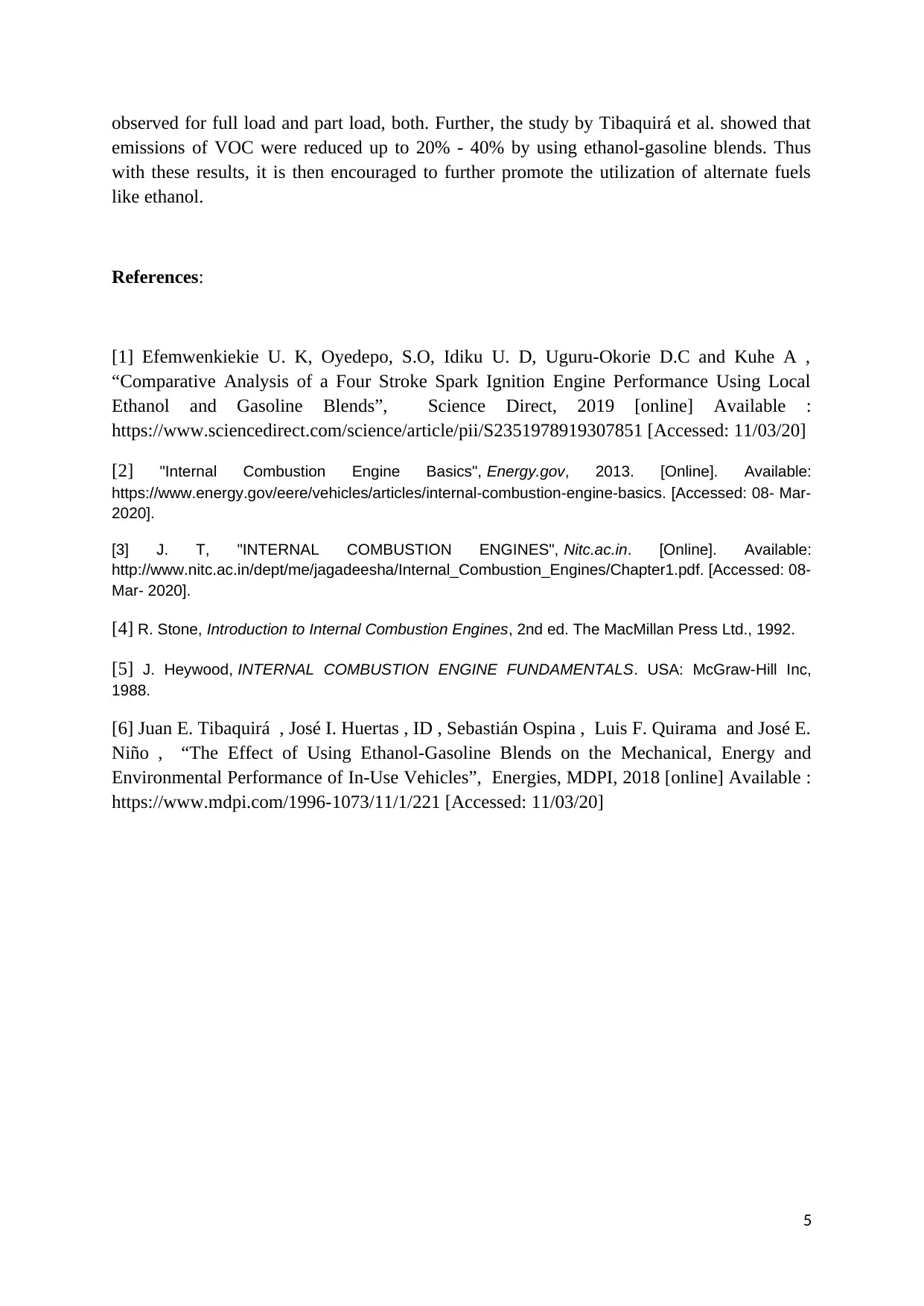
observed for full load and part load, both. Further, the study by Tibaquirá et al. showed that
emissions of VOC were reduced up to 20% - 40% by using ethanol-gasoline blends. Thus
with these results, it is then encouraged to further promote the utilization of alternate fuels
like ethanol.
References:
[1] Efemwenkiekie U. K, Oyedepo, S.O, Idiku U. D, Uguru-Okorie D.C and Kuhe A ,
“Comparative Analysis of a Four Stroke Spark Ignition Engine Performance Using Local
Ethanol and Gasoline Blends”, Science Direct, 2019 [online] Available :
https://www.sciencedirect.com/science/article/pii/S2351978919307851 [Accessed: 11/03/20]
[2] "Internal Combustion Engine Basics", Energy.gov, 2013. [Online]. Available:
https://www.energy.gov/eere/vehicles/articles/internal-combustion-engine-basics. [Accessed: 08- Mar-
2020].
[3] J. T, "INTERNAL COMBUSTION ENGINES", Nitc.ac.in. [Online]. Available:
http://www.nitc.ac.in/dept/me/jagadeesha/Internal_Combustion_Engines/Chapter1.pdf. [Accessed: 08-
Mar- 2020].
[4] R. Stone, Introduction to Internal Combustion Engines, 2nd ed. The MacMillan Press Ltd., 1992.
[5] J. Heywood, INTERNAL COMBUSTION ENGINE FUNDAMENTALS. USA: McGraw-Hill Inc,
1988.
[6] Juan E. Tibaquirá , José I. Huertas , ID , Sebastián Ospina , Luis F. Quirama and José E.
Niño , “The Effect of Using Ethanol-Gasoline Blends on the Mechanical, Energy and
Environmental Performance of In-Use Vehicles”, Energies, MDPI, 2018 [online] Available :
https://www.mdpi.com/1996-1073/11/1/221 [Accessed: 11/03/20]
5
emissions of VOC were reduced up to 20% - 40% by using ethanol-gasoline blends. Thus
with these results, it is then encouraged to further promote the utilization of alternate fuels
like ethanol.
References:
[1] Efemwenkiekie U. K, Oyedepo, S.O, Idiku U. D, Uguru-Okorie D.C and Kuhe A ,
“Comparative Analysis of a Four Stroke Spark Ignition Engine Performance Using Local
Ethanol and Gasoline Blends”, Science Direct, 2019 [online] Available :
https://www.sciencedirect.com/science/article/pii/S2351978919307851 [Accessed: 11/03/20]
[2] "Internal Combustion Engine Basics", Energy.gov, 2013. [Online]. Available:
https://www.energy.gov/eere/vehicles/articles/internal-combustion-engine-basics. [Accessed: 08- Mar-
2020].
[3] J. T, "INTERNAL COMBUSTION ENGINES", Nitc.ac.in. [Online]. Available:
http://www.nitc.ac.in/dept/me/jagadeesha/Internal_Combustion_Engines/Chapter1.pdf. [Accessed: 08-
Mar- 2020].
[4] R. Stone, Introduction to Internal Combustion Engines, 2nd ed. The MacMillan Press Ltd., 1992.
[5] J. Heywood, INTERNAL COMBUSTION ENGINE FUNDAMENTALS. USA: McGraw-Hill Inc,
1988.
[6] Juan E. Tibaquirá , José I. Huertas , ID , Sebastián Ospina , Luis F. Quirama and José E.
Niño , “The Effect of Using Ethanol-Gasoline Blends on the Mechanical, Energy and
Environmental Performance of In-Use Vehicles”, Energies, MDPI, 2018 [online] Available :
https://www.mdpi.com/1996-1073/11/1/221 [Accessed: 11/03/20]
5
1 out of 5
Related Documents
Your All-in-One AI-Powered Toolkit for Academic Success.
+13062052269
info@desklib.com
Available 24*7 on WhatsApp / Email
![[object Object]](/_next/static/media/star-bottom.7253800d.svg)
Unlock your academic potential
Copyright © 2020–2025 A2Z Services. All Rights Reserved. Developed and managed by ZUCOL.




